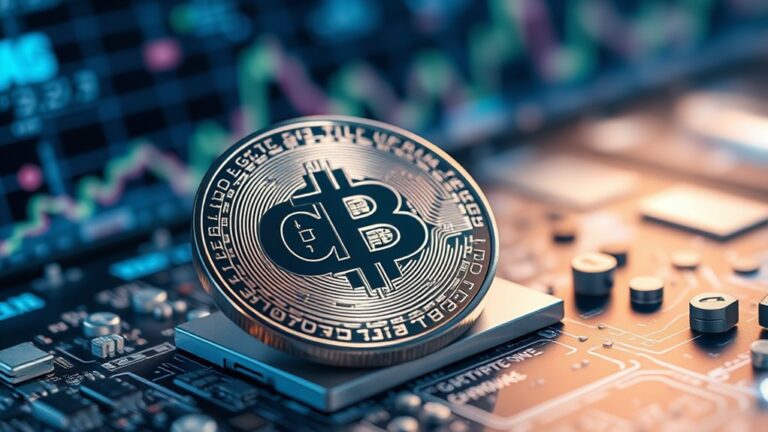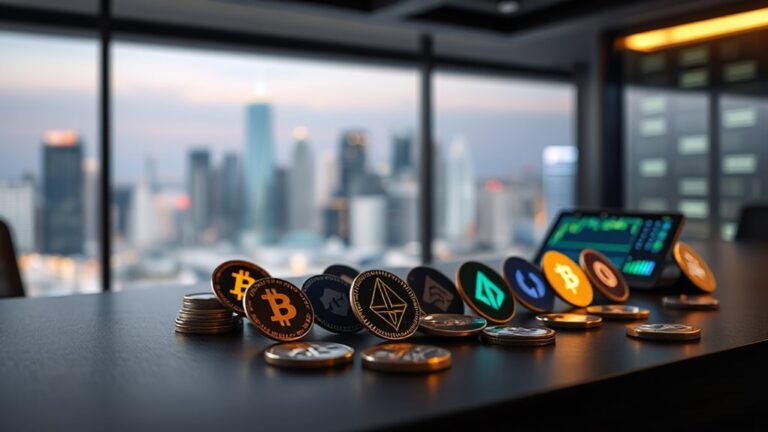
Future of Altcoins: Trends and Predictions for 2025
Altcoins are anticipated to grow considerably by 2025 due to increased adoption, regulatory clarity, and technological advancements. Emerging sectors like decentralized finance and AI-integrated altcoins offer real-world applications. Regulatory improvements and institutional involvement enhance investor confidence. Bitcoin and Ethereum's evolving roles influence altcoin trends, as profits often flow from major cryptocurrencies to altcoins. Developments in scalability and user experience contribute to broader acceptance. For a deeper insight into these trends and predictions, explore the subsequent sections.
Key Takeaways
- Altcoin adoption in retail and eCommerce will expand, driven by increasing utility beyond Bitcoin and Ethereum.
- Regulatory clarity will enhance investor confidence and institutional adoption, legitimizing altcoins by 2025.
- The growth of Web3 and AI technologies will boost altcoin innovations and real-world applications.
- DeFi and Layer 2 advancements will improve altcoin scalability and financial service offerings.
- Mainstream acceptance and integration with mobile wallets will simplify altcoin transactions and usage.
Market Indicators and Altcoin Trends

In the domain of cryptocurrency, understanding market indicators and altcoin trends is essential for investors and enthusiasts alike. Increased adoption of altcoins in retail and eCommerce is expanding their utility beyond Bitcoin and Ethereum, signaling a shift in payment preferences. Clearer regulatory frameworks could enhance altcoin adoption by providing investors with more confidence and stability, though market volatility remains a concern due to speculation. Altcoins are often seen as speculative assets, which makes them less stable compared to major cryptocurrencies. Their performance often follows seasonal patterns linked to Bitcoin's price movements. The introduction of altcoin ETFs is expected to boost mainstream adoption, while institutional participation could increase market stability. Active portfolio management will become vital as investors seek diversification. It's important to assess a coin's market capitalization as it can provide insights into the project's potential and stability.
The Influence of Bitcoin and Ethereum

The interplay between Bitcoin and Ethereum greatly shapes the landscape of altcoins, underscoring their influence on the market.
Historical patterns reveal that altcoin seasons often emerge after substantial Bitcoin price increases, enticing investors to explore other opportunities. Typically, Bitcoin's market dominance decreases during these periods, providing altcoins with more market share. Additionally, profits from Bitcoin are often reinvested into altcoins, fueling their growth.
Altcoin seasons follow Bitcoin's price surges, as investors seek new opportunities and reinvest profits into altcoins.
Ethereum, on the other hand, plays a pivotal role through its smart contract capabilities, fostering the development of numerous altcoins. Its blockchain platform encourages adoption due to its robust ecosystem for decentralized apps. Ethereum's transition from proof-of-work to proof-of-stake with "The Merge" has also enhanced its efficiency and scalability, further solidifying its position as a leader in the blockchain space.
Ethereum's substantial market capitalization and leadership in blockchain innovation support stability and growth in the altcoin space, particularly within decentralized finance (DeFi) projects.
Macroeconomic Drivers and Regulatory Impact

Macroeconomic factors and regulatory developments profoundly influence the altcoin market, shaping its growth and investor behavior.
Inflation trends play an essential role; lower inflation could lead to interest rate cuts, increasing liquidity in cryptocurrencies, while high inflation may prompt stablecoin adoption in affected regions.
Interest rates and monetary policy are pivotal, as high rates could limit altcoin liquidity, whereas accommodative policies might stimulate growth. The Federal Reserve's decisions greatly impact market dynamics.
Global economic stability often encourages investment in riskier assets like altcoins, while downturns may dampen growth.
Regulatory clarity is vital for confidence and institutional adoption. Favorable regulations and potential ETF approvals could legitimize altcoins, enhancing their appeal to broader investor bases.
In the future, institutional adoption of altcoins as part of diversified portfolios could further drive their mainstream acceptance and growth.
Emerging Altcoins and Innovation Sectors

Shifting focus from macroeconomic drivers and regulatory impacts, the domain of emerging altcoins and innovation sectors is gaining momentum in the cryptocurrency landscape.
Altcoins are increasingly integrating with new technologies, driving advancements in various sectors. Web3 innovations are enhancing user experience and decentralization, while AI-integrated altcoins like Dawgz AI provide real-world utilities through trading tools and NFTs.
Altcoins foster innovation, merging Web3 and AI for enhanced decentralization and utility in trading and NFTs.
Projects in the decentralized finance (DeFi) space are leveraging blockchain technology for improved financial services. Additionally, altcoins like Aptos and Arbitrum are focusing on blockchain scalability and efficiency. Layer 2 technologies such as rollups, sidechains, and state channels are pivotal in enhancing scalability by processing transactions more efficiently, reducing congestion and fees while maintaining security.
The integration of cloud computing with blockchain enhances data management and security. Key projects such as Alephium, ThoughtAI, and WorldCoin highlight the diversification and potential of these emerging sectors.
Adoption, Use Cases, and Market Projections

As cryptocurrencies continue to weave into the fabric of daily transactions, their adoption and use cases are expanding greatly. Mainstream companies like Microsoft, PayPal, and Starbucks already accept cryptocurrencies, indicating a trend towards wider acceptance by 2025.
The increasing regulatory clarity offers security to investors, fostering institutional involvement. Mobile wallets and contactless payment methods simplify cryptocurrency usage. Stablecoins address volatility concerns, promoting everyday use.
Beyond finance, cryptocurrencies transform sectors such as voting, supply chain management, and healthcare. Digital wallets and NFTs enhance accessibility and asset ownership. Well-designed regulations could foster mainstream adoption and sustainable growth in the digital asset ecosystem while protecting consumers and financial systems.
Market projections suggest the global cryptocurrency market could reach $5 billion by 2030. Bitcoin's value is expected to rise greatly, while altcoin ETFs may gain prominence, providing broader access to digital assets.
Frequently Asked Questions
What Impact Will Geopolitical Stability Have on Altcoin Markets?
Geopolitical stability fosters clearer regulatory frameworks, enhancing market confidence and reducing volatility in altcoin investments. This environment encourages both institutional and retail participation, accelerating technological advancements, adoption, and integration of altcoins into mainstream financial systems.
How Might Environmental Concerns Affect Altcoin Mining Practices?
Environmental concerns could drive altcoin mining towards sustainable practices. Adoption of renewable energy, improved e-waste management, and alternative consensus mechanisms may reduce ecological impacts, while regulatory pressures incentivize cleaner energy use and technological efficiency improvements.
What Role Will Decentralized Governance Play in Altcoin Development?
Decentralized governance holds the key to altcoin evolution, empowering communities with decision-making power. As DAOs rise, their influence could redefine altcoin trajectories, fostering innovation and resilience amidst ever-shifting regulatory landscapes and technological advancements.
How Will Cybersecurity Threats Influence Altcoin Adoption?
Cybersecurity threats, such as phishing and smart contract vulnerabilities, pose significant risks to altcoin adoption. These threats deter potential investors, necessitating robust security measures and international cooperation to build trust and guarantee market stability.
In What Ways Will Consumer Behavior Shifts Affect Altcoin Usage?
Consumer behavior shifts, a double-edged sword, drive altcoin usage as millennials and Gen Z embrace decentralized systems. Their preference for digital assets alongside rising awareness and education propels integration into daily transactions, influencing altcoin adoption.
Conclusion
In the satirical symphony of the altcoin world, one might note the curious dance with Bitcoin and Ethereum, reminiscent of a sibling rivalry. While macroeconomic forces and regulatory whispers play the role of strict chaperones, emerging altcoins waltz into new sectors, hoping for a spotlight. Adoption grows, use cases multiply, and market projections predict a future as stable as a toddler's first steps. Yet, in this grand performance, the audience remains watchful, ever curious about the next act.












